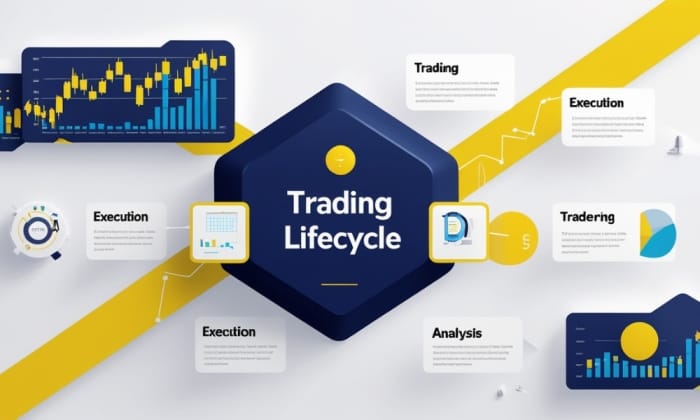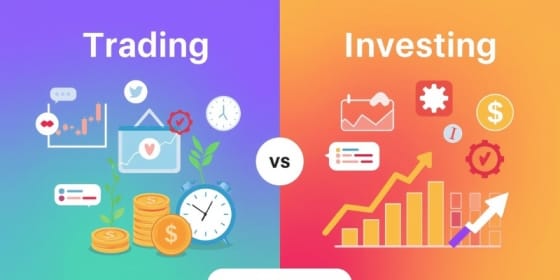You are considering trading if you have ever questioned how others purchase and sell commodities, currencies, or stocks and profit from it. Though only when done with the correct knowledge and strategy, trading can be a great approach to increase wealth. From what it is, the several forms it takes, to professional advice for beginners, this guide will walk you through all you need to know before beginning your trading.
Table of Contents
📌 What is Trading?
Buying and selling financial assets, such as stocks, bonds, currencies, or commodities, with the intention of turning a profit is known as trading. The goal of traders is to profit from changes in price over brief or extended periods of time.
Example:
You buy a stock at ₹100 and sell it at ₹120. The ₹20 profit (minus fees) is your trading gain.
🧱 Types of Trading
Trading isn’t one-size-fits-all. There are different styles depending on your risk appetite, time availability, and goals.
Type of Trading | Time Horizon | Skill Level Required | Common Assets Traded |
Intraday Trading | Minutes to hours | High | Stocks, Forex |
Swing Trading | Days to weeks | Medium | Stocks, Crypto |
Position Trading | Weeks to months | Low to Medium | Stocks, ETFs |
Scalping | Seconds to minutes | Very High | Forex, Derivatives |
📊 How the Trading Process Works
- Market Research – Analyze the stock or market using technical or fundamental analysis.
- Place an Order – Buy/sell using a trading platform like Zerodha, Angel One, Upstox, or Dhan.
- Monitor the Position – Use charts and indicators to track price movements.
- Exit Trade – Sell the asset when your target or stop-loss is hit.

⚖️ Trading vs. Investing
Feature | Trading | Investing |
Time Horizon | Short-term | Long-term |
Risk | High | Moderate |
Return Potential | High (with risk) | Compounded growth over time |
Example | Buy today, sell tomorrow | Buy and hold for 5+ years |
💡 Tip: Beginners should learn investing first and move to trading once confident.

📈 Popular Trading Strategies
🎯 1. Momentum Trading – Riding the trend of strong-moving stocks.
🔁 2. Mean Reversion – Betting the price will return to its average.
🔐 3. Breakout Trading – Buying after a price breaks key resistance.
🔻 4. Short Selling – Profiting when prices fall. (Advanced)
🧠 Expert Opinion: “The best strategy is the one you can stick to. Simplicity wins.” – Rakesh Jhunjhunwala (Late)
🔍 Tools & Platforms You’ll Need
- Broker: Zerodha, Upstox, Angel One, Dhan
- Charting Tool: TradingView, MetaTrader
- News Feed: Moneycontrol, Economic Times
- Learning Resources: NSE Academy, Investopedia
✅ Choose platforms that offer real-time data, fast execution, and low charges.
🚨 Risks of Trading (And How to Manage Them)
- Market Volatility
- Emotional Trading
- Overleveraging
- Lack of Knowledge
💡 Risk Management Tips:
- Always use a stop-loss
- Don’t risk more than 2% of your capital per trade
- Backtest your strategy before using real money
🎯 Pro Tips for Beginner Traders
✅ Start with a demo account
✅ Focus on learning, not earning
✅ Journal every trade
✅ Avoid following random tips blindly
✅ Learn from your losses
🗂️ Case Study: Real-Life Trading Success
Ankit, a 25-year-old software engineer, started trading part-time using the momentum strategy. He started with ₹25,000 and grew it to ₹1.2 lakh in 10 months through consistent learning, backtesting, and following risk management rules.
🔗 External Useful Links:
- NSE Academy: Learn Trading
- SEBI Official Site
- Zerodha Varsity – Education
- TradingView India
🧠 Final Thoughts
Trading can be rewarding, but it’s not a shortcut to riches. It requires education, discipline, and patience. Start small, stay consistent, and never stop learning.
❗ 📢Disclaimer
Trading in financial markets involves risk and is not suitable for all investors. This blog post is for educational purposes only and should not be taken as financial advice. Investment in the securities market is subject to market risks. Please read all scheme-related documents carefully before investing. The information provided in this article is for educational and informational purposes only and is not intended as investment advice. Trading in derivatives, including options, involves substantial risk and is not suitable for all investors. Past performance is not indicative of future results. Readers are advised to consult with their financial advisors before making any trading decisions.
❓ FAQs
1. Is it legal to trade in India?
Yes, it is entirely legal to trade in India using platforms that are registered with SEBI.
2. Can I use ₹1,000 to trade?
Indeed, you can begin modestly with platforms such as Dhan or Zerodha, particularly when it comes to fractional investing in options or mutual funds.
3. In India, when is the ideal time to trade?
For liquidity and momentum, this is usually between 9:15 AM and 10:30 AM and 1:30 PM and 2:30 PM.
4. How much time does it take to start making money as a trader?
It typically requires six to twelve months of regular study and practice.

